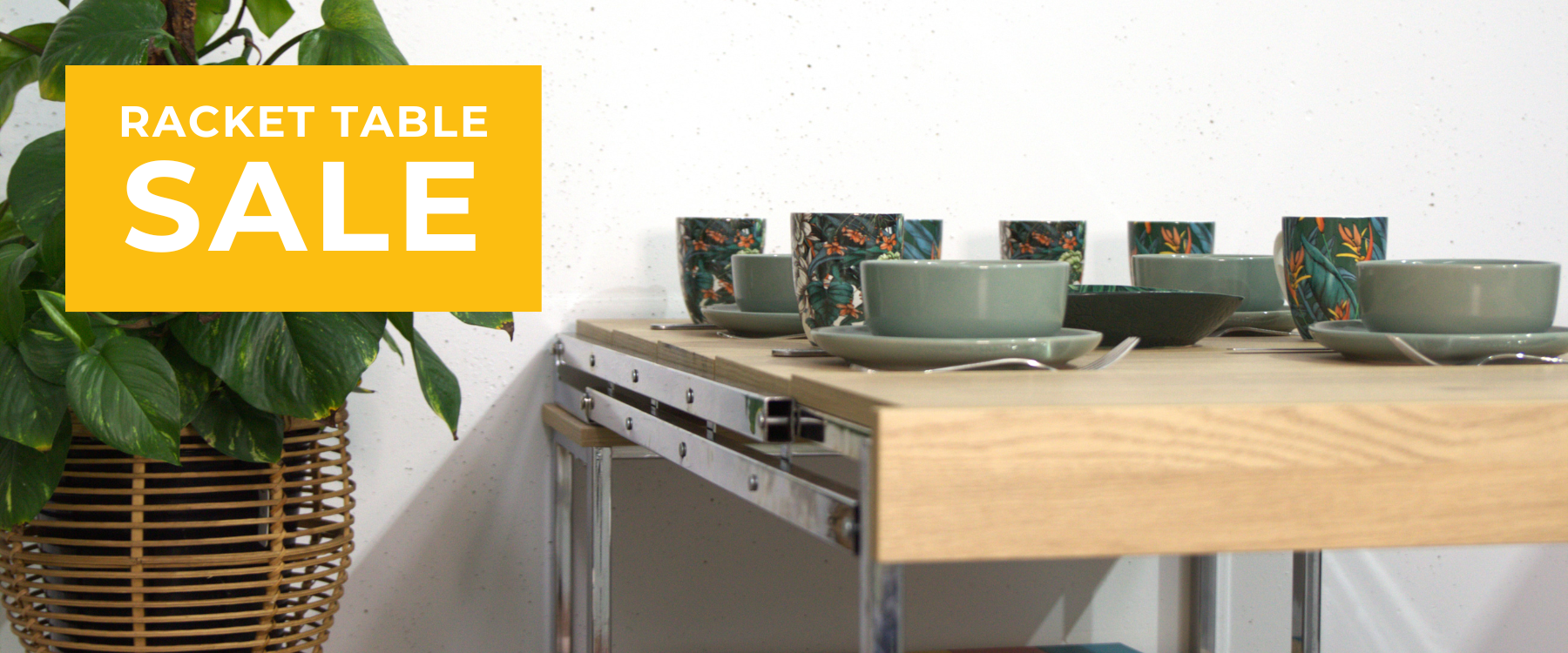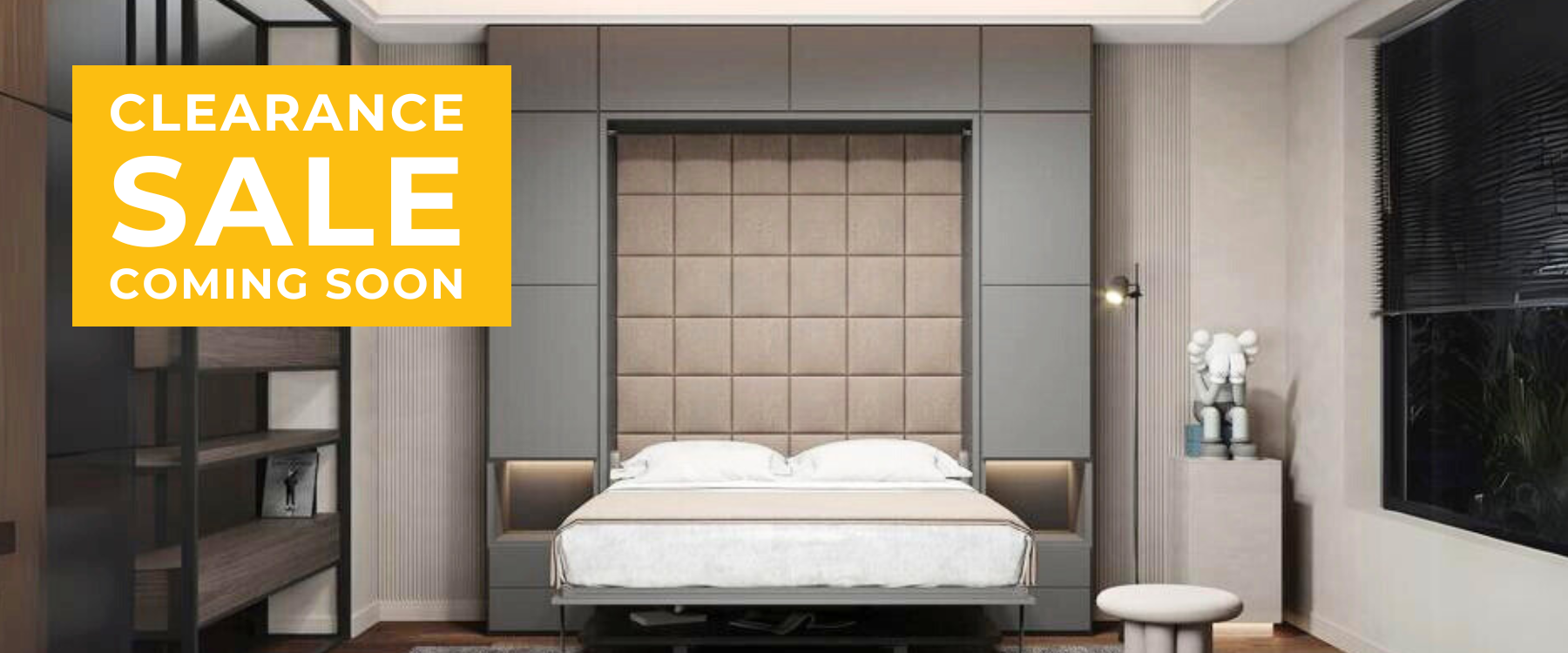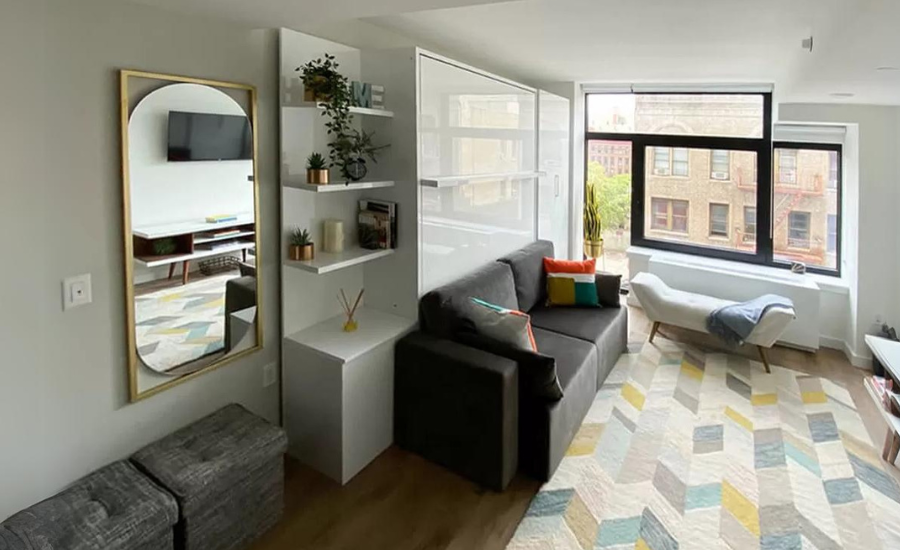
|
Traditional homes are slowly giving way to apartments and smaller homes. This form of living is gaining popularity among younger generations as it offers cosiness while being easy to maintain and pay for. Living in smaller houses, like an apartment, is also a practical and fun option for urban dwellers who love to travel or like to live alone. But scaling down for a small home is challenging. How does one make it a cosy yet personalised dwelling? Our handy space-saving furniture guide lets you enjoy your dream home without feeling cramped. |

Tips For Choosing Space-Saving FurnitureChoosing space-saving furniture involves considering several factors to ensure you maximise the utility of your space while maintaining comfort and style. Here are some steps and tips to help you select the right space-saving furniture.
|

Types Of Furniture That Save SpaceNow that you have assessed your room and know what you need for it, it’s time to consider the space-saving furniture options available. There are several options available in the market today. Read on to learn more. Space-Saving FurnitureSpace-saving furniture, as the name suggests, is furniture designed to maximise limited space, making small areas more functional and efficient. This type of furniture often features multifunctional, foldable, or modular designs that can serve multiple purposes or be easily stowed away when not in use. Examples include fold-out beds, nesting tables, extendable dining tables, and storage-integrated seating. The goal of space-saving furniture is to provide the necessary functionality without occupying unnecessary space, making it ideal for small apartments, studios, and compact living environments. Here are some of the most popular types of space-saving furniture:
By incorporating these types of space-saving furniture into your home, you can make the most of your space without sacrificing style or functionality. |
Transformable FurnitureTransformable furniture refers to furnishings that can change form or function to adapt to different needs and spaces. This type of furniture is designed with mechanisms or features that allow it to be converted from one piece of furniture to another or to alter its configuration for varied uses. The goal is to enhance versatility and utility, making it suitable for small or multifunctional spaces. Common examples of transformable furniture include:
Transformable furniture is designed with an emphasis on functionality, efficiency, and innovative use of space. It often incorporates smart engineering and design elements to ensure ease of transformation and durability. This type of furniture is particularly popular in urban areas where living spaces are often limited, and there is a need to make the most of every square metre. |

Functional FurnitureFunctional furniture refers to furnishings designed primarily for practical purposes, offering usability and convenience in daily activities. The focus of functional furniture is on performance, efficiency, and utility, ensuring that each piece fulfils its intended role effectively while often integrating additional features to enhance its usefulness. Key characteristics of functional furniture include:
Examples of functional furniture include ergonomic office chairs designed for comfort and support during long hours of work, storage ottomans that provide seating and storage space, and modular shelving units that can be customised to fit various spaces and needs. Difference between Space-Saving, Transformable and Functional FurnitureThe primary differences between space-saving, transformable, and functional furniture are their specific design goals and features. While they share some similarities, each type has unique characteristics that set it apart. |
Space-Saving vs Transformable vs Functional Furniture
|
Feature/Aspect |
Space-Saving Furniture |
Transformable Furniture |
Functional Furniture |
|
Goal |
Maximise use of limited space |
Provide versatility by changing form/function |
Offer practical usability and convenience |
|
Features |
Compact, foldable, multi-functional designs |
Mechanisms to convert from one form to another |
Design elements enhancing primary function |
|
Examples |
Fold-out beds, nesting tables, extendable dining tables, storage-integrated seating |
Sofa beds, Murphy beds, extendable dining tables, convertible desks |
Ergonomic office chairs, storage ottomans, modular shelving units |
|
Focus |
Efficiency in space utilisation |
Flexibility and adaptability |
Practicality and reliability |
|
Comparison Focus |
Reducing footprint |
Changing form or function for multiple uses |
Performing the intended role effectively |
Portable FurniturePortable furniture refers to furnishings designed to be easily moved from one location to another, providing flexibility and convenience for users. These pieces are typically lightweight, compact, and often collapsible or foldable, allowing easy transportation and storage. Portable furniture is popular for its versatility and suitability for various settings, including indoor and outdoor use. Examples of portable furniture include folding chairs, collapsible tables, inflatable mattresses, and lightweight camping furniture. The primary advantage of portable furniture is its ability to adapt to different environments and situations. Though generally preferred for temporary living arrangements, outdoor activities, and events, portable furniture can also be ideal for small spaces. |

Benefits And Importance Of Space-Saving FurnitureWhy Is Space-Saving Furniture Good?Space-saving furniture is an excellent choice for modern living due to its ability to maximise the utility of limited spaces without compromising comfort or style. This type of furniture is specifically designed to make the most of every available inch, offering practical solutions for small apartments, compact homes, and multifunctional areas. Here’s a detailed look at why space-saving furniture is beneficial: Maximises Space EfficiencySpace-saving furniture is designed to fit into small or awkward spaces, allowing you to make the most of your available area. This is especially useful in urban settings, where living spaces are often limited. Multi-FunctionalityMany space-saving pieces serve more than one purpose. For example, a sofa bed can function as both a seating area and a sleeping space, and a dining table with built-in storage can double as a storage unit. This multi-functionality reduces the need for multiple pieces of furniture, saving space. Enhances AestheticsWell-designed space-saving furniture can enhance a room's visual appeal. By eliminating clutter and providing a streamlined look, these pieces can make even small rooms feel open and inviting. Improves OrganisationSpace-saving furniture often includes built-in storage solutions, such as beds with drawers or coffee tables with compartments. These features help keep living spaces organised and free of clutter. Flexibility and AdaptabilitySpace-saving furniture is often modular, foldable, or movable, allowing you to easily reconfigure your space as needed. This flexibility is perfect for multifunctional rooms or for accommodating guests. Cost-EffectiveInvesting in multi-functional, space-saving furniture can be more cost-effective than purchasing multiple pieces of traditional furniture. You get the benefits of several pieces of furniture in one, reducing the overall cost. Easy to MoveLightweight and often collapsible, space-saving furniture is easy to move and transport. This is ideal for people who move frequently or like to rearrange their living spaces regularly. Enhances Small Space LivingSpace-saving furniture can dramatically improve the quality of life for those living in small apartments or tiny homes. It allows residents to enjoy all the comforts and functionalities of a larger home within a smaller footprint. Promotes MinimalismSpace-saving furniture aligns with minimalist living principles by encouraging the use of fewer, more purposeful items. This can lead to a more organised and peaceful living environment. How Does Multi-Functional Furniture Help To Optimise Space?Multi-functional furniture plays a crucial role in optimising space in a living environment by offering multiple uses within a single piece, thereby reducing the need for additional furniture and freeing up valuable floor space. Here’s a detailed explanation of how multi-functional furniture contributes to space optimisation: Reduces Clutter
Maximises Utility
Enhances Versatility
Promotes Minimalism
Cost-Effective Solution
Enhances Aesthetic Appeal
Facilitates Easy Movement
|
How Can Space-Saving Furniture Benefit Those Living In Small Apartments?As more people shift to living in small apartments or units, investing in space-saving furniture is becoming the new norm. Space-saving furniture can greatly benefit individuals living in small apartments by providing them with a number of advantages. These advantages include:
|
Furniture Ideas For Small Apartments Or HomesInnovative space-saving furniture solutions can dramatically enhance the functionality and comfort of small apartments or homes. Here are some detailed examples that showcase clever design and versatility: Murphy Beds (Wall Beds)Murphy beds fold against the wall when not in use, freeing up valuable floor space during the day. Some modern Murphy beds have integrated shelving, desks, or sofas, making them highly versatile. These designs allow you to transform a bedroom into a home office or living room without compromising on the comfort of a full-sized bed at night. Sofa Beds and FutonsSofa beds and futons serve as comfortable seating during the day and can be converted into beds at night. Many contemporary designs include storage compartments within the base or armrests, providing a convenient place to store bedding or other items. This dual functionality is perfect for small living rooms or studio apartments with limited space. Extendable Dining TablesExtendable dining tables can be adjusted to accommodate more people when needed. When not extended, they occupy minimal space, making them ideal for small dining areas. Some innovative designs feature built-in storage for table leaves or additional seating, seamlessly integrating extra functionality into a compact form. Nesting TablesNesting tables are sets of tables that can be stacked together to save space when not in use. They can be easily separated to provide additional surface area when needed. This flexibility makes them perfect for small living rooms, where they can serve as side tables, coffee tables, or extra surfaces for entertaining guests. Fold-Out DesksFold-out desks can be mounted on walls or stored within cabinets, providing a workspace that can be neatly stowed away when not in use. Some models include integrated shelving or cork boards, adding storage and organisational features to maximise their utility. These desks are ideal for small home offices or multipurpose rooms. Loft BedsLoft beds are elevated on a high frame, leaving space underneath for other uses. The area beneath can be used for a desk, seating area, or additional storage, effectively doubling the functionality of a single room. Loft beds are especially useful in children's rooms or studio apartments where maximising floor space is crucial. Convertible Coffee TablesConvertible coffee tables can be raised or extended to serve as dining tables or desks. Many designs also include hidden storage compartments for books, magazines, or other items. This multifunctionality makes them a practical addition to small living rooms, allowing the same piece of furniture to serve multiple purposes. Modular SofasModular sofas can be reconfigured into different shapes and sizes to suit various needs. They can be arranged to create seating areas, sleeping spaces, or even storage solutions. This adaptability makes modular sofas perfect for small living spaces that require frequent rearrangement or multifunctional use. Wall-Mounted Drop-Leaf TablesWall-mounted drop-leaf tables are attached to the wall and can be folded down when not in use. These tables are ideal for small kitchens or dining areas, providing a functional surface that can save space. Some designs also incorporate storage shelves or hooks, adding further utility. Storage OttomansStorage ottomans are versatile pieces with hollow interiors that can be used for storage. They can also serve as additional seating or tables. The dual-purpose nature of storage ottomans makes them valuable in small living rooms or bedrooms, where every piece of furniture needs to offer maximum functionality. Hidden Storage BedsHidden storage beds feature drawers or compartments built into the frame, providing a place to store bedding, clothing, or other items. Lift-up bed bases offer easy access to large storage areas, making efficient use of the space under the bed. These beds are perfect for small bedrooms, helping to keep the room organised and clutter-free. Wall-Mounted Shelving UnitsWall-mounted shelving units save floor space by utilising vertical space. Some innovative designs include fold-out desks or workspaces, providing additional functionality without occupying extra space. These units are ideal for small apartments, offering storage and workspace solutions that keep the floor clear. Transformable Kitchen IslandsTransformable kitchen islands can expand, contract, or have additional fold-out surfaces. Some models include built-in seating, storage, or even appliances, maximising utility in compact kitchens. These kitchen islands provide a versatile solution for small kitchens, offering extra prep space, dining areas, and storage. Sliding Door WardrobesSliding door wardrobes do not require extra space to open, making them ideal for small bedrooms or hallways. Some designs include mirrors, pull-out drawers, or integrated lighting, enhancing functionality and convenience. These wardrobes help to maximise storage without encroaching on floor space. Compact Laundry SolutionsCompact laundry solutions, such as combination washer-dryer units or fold-away laundry stations, are designed to fit into small spaces. Some designs incorporate ironing boards, drying racks, or folding tables, optimising laundry tasks in compact living environments. These solutions are perfect for small apartments that lack dedicated laundry rooms. What Are Some Space-Saving Furniture Ideas For Home Offices Or Workspaces?Creating an efficient and comfortable home office or workspace in a small area can be challenging, but space-saving furniture can help you make the most of your available space. Here are some ideas to consider: Wall-Mounted DesksWall-mounted desks are attached directly to the wall, freeing up floor space and providing a dedicated workspace that can be folded away when not in use. Many models come with built-in shelves or compartments to store office supplies and paperwork. Fold-Out DesksFold-out desks can be mounted on walls or stored within cabinets, providing a pop-up workspace that can be easily hidden away when not needed. Some designs include additional features like cork boards, chalkboards, or whiteboards for added functionality. Compact Desk UnitsCompact desk units are designed for small spaces, offering a streamlined workspace with a minimal footprint. These desks often come with built-in storage solutions such as drawers, shelves, or cubbies to keep essentials organised. Standing DesksStanding desks encourage movement and can be adjusted to different heights, promoting better posture and health. Some standing desks have a small footprint and can be easily moved or adjusted to fit into tight spaces. Under-Desk StorageUtilise the space under your desk with storage solutions like rolling carts, drawers, or shelves to keep your workspace tidy and free of clutter. These storage options keep frequently used items within easy reach without taking up additional floor space. Modular Office FurnitureModular office furniture can be rearranged to fit different spaces and needs, making it highly adaptable. Look for modular desks, shelves, and seating that can be configured in various ways to optimise your workspace. Multi-Functional FurnitureChoose furniture that serves more than one function, such as a desk that doubles as a storage unit or a bookshelf that incorporates a fold-out desk. These pieces help reduce the number of items needed in your home office, freeing up space. Floating ShelvesFloating shelves use vertical wall space, providing storage for books, office supplies, and decorative items without occupying floor space. They add a sleek and modern look to your workspace while keeping it organised. Convertible TablesConvertible tables can be used as desks, dining tables, or craft tables, offering flexibility in small spaces. Some designs can be extended, folded, or adjusted to different heights, making them versatile for various tasks. Murphy DesksSimilar to Murphy beds, Murphy desks fold down from the wall to create a workspace and can be folded up when not in use. Many designs include shelves or cabinets for additional storage. Corner DesksCorner desks make use of often-overlooked corner spaces, providing a functional workspace without taking up much room. They are designed to maximise desk space while keeping everything within easy reach. |
What Are Some Examples Of Space-Saving Furniture Designed For Outdoor Areas?Creating a functional and inviting outdoor space on balconies or patios often requires space-saving furniture that maximises limited areas. Examples include folding bistro sets and stackable chairs, which can be easily stored when not in use. These options are not only compact but also lightweight and portable, making them perfect for small outdoor spaces. Other space-saving solutions include wall-mounted folding tables and compact outdoor sofas. Wall-mounted tables can be folded away to save space, while compact sofas offer comfortable seating without a large footprint. Multi-functional furniture, such as storage benches and folding loungers, provides additional benefits by combining seating with storage and being easy to store when not in use. Hanging chairs, hammocks, and hanging planters utilise vertical space, freeing up the floor and adding a cosy, decorative touch to the outdoor environment. Lastly, balcony rail tables and folding side tables efficiently use available space by attaching to rails or being easily stored when not needed. Outdoor storage ottomans and nesting tables offer multifunctional options for seating, storage, and additional surfaces, helping to keep outdoor areas organised and stylish without taking up too much space. |






















